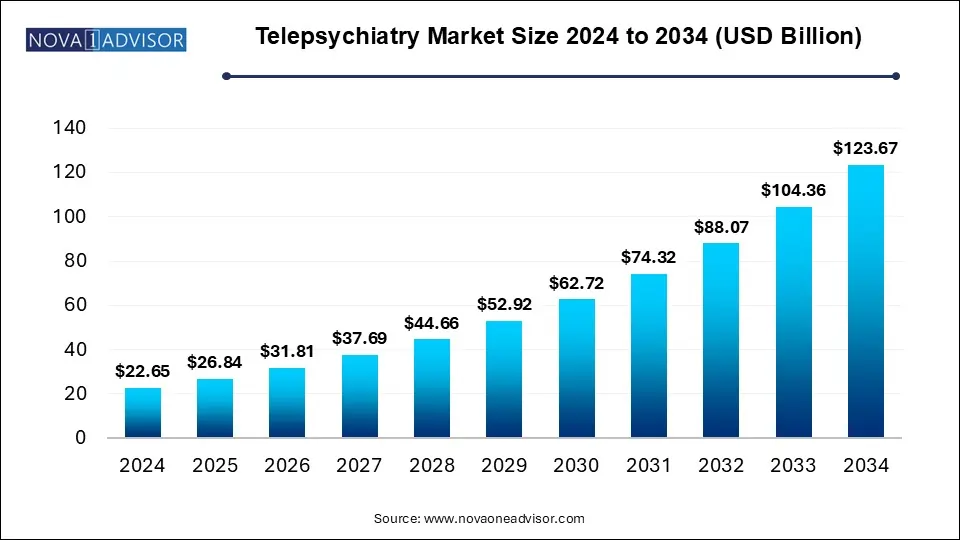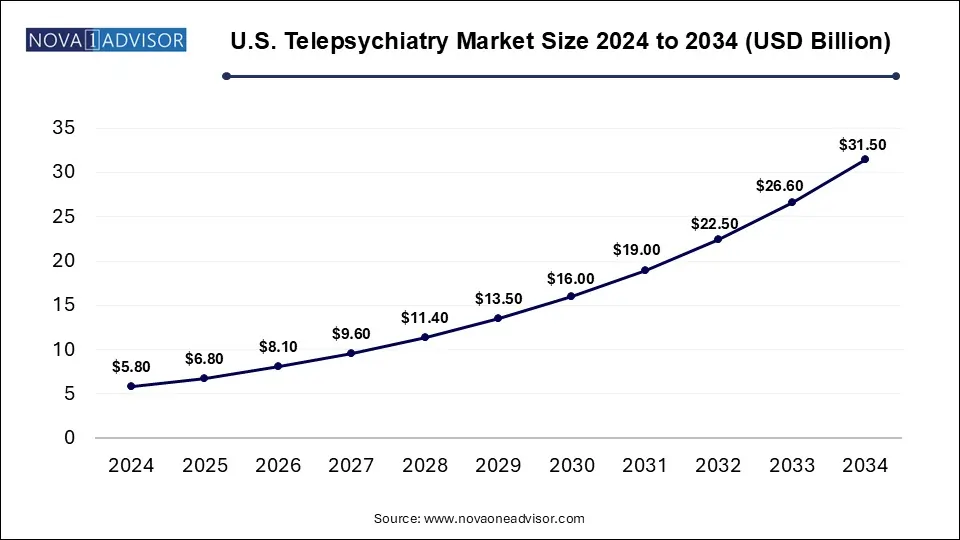Telepsychiatry Market Size and Growth
The telepsychiatry market size was exhibited at USD 22.65 billion in 2024 and is projected to hit around USD 123.67 billion by 2034, growing at a CAGR of 18.5% during the forecast period 2025 to 2034.

Telepsychiatry Market Key Takeaways
- In 2024, the in-home solutions segment led the telepsychiatry market, accounting for approximately 37.0% of the total revenue. Meanwhile, the crisis solutions segment is projected to expand steadily, with a compound annual growth rate (CAGR) of 18.8%.
- The adult segment dominated the market, holding around 58.0% of the revenue share in 2024. Conversely, the pediatric and adolescent segment is expected to experience rapid growth, with a projected CAGR of 18.7%.
- Community mental health centers were the leading providers in the telepsychiatry industry, capturing over 28.8% of the market share in 2024. Additionally, the homecare segment is anticipated to witness the fastest growth, with a forecasted CAGR of 19.9% over the coming years.
- Geographically, North America emerged as the dominant region in the global telepsychiatry market, securing a revenue share of 34.0% in 2024.
U.S. Telepsychiatry Market Size and Growth 2025 to 2034
The U.S. telepsychiatry market size was valued at USD 5.8 billion in 2024 and is expected to reach around USD 31.5 billion by 2034, growing at a CAGR of 16.62% from 2025 to 2034.

In 2024, North America led the global telepsychiatry market, accounting for 34.0% of total revenue. This growth is driven by increasing smartphone penetration, supportive reimbursement policies, and the presence of numerous industry players in the region. Additionally, the COVID-19 pandemic accelerated the adoption of this technology, with the Centers for Medicare & Medicaid Services (CMS) and the Food and Drug Administration (FDA) recognizing telemedicine and virtual care as vital components of the pandemic response, further propelling the regional telepsychiatry sector.
U.S. Telepsychiatry Market Trends
The U.S. telepsychiatry market held a substantial share of the North American segment, fueled by rising awareness of mental health issues, advancements in digital healthcare, and favorable telehealth regulations. Key industry trends include the integration of Artificial Intelligence (AI), remote medication management, and tailored solutions for underserved populations, such as rural communities and correctional facilities. Telepsychiatry's adaptability and accessibility have positioned it as a crucial tool for addressing mental health needs across various sectors, including workforce support, school-based services, and crisis intervention. Its growing adoption across diverse demographics and healthcare settings is driven by cost-effectiveness, increasing consumer confidence, and widespread availability.
Europe Telepsychiatry Market Trends
The European telepsychiatry market is undergoing a major transformation, spurred by heightened awareness of mental health concerns and the adoption of advanced technologies. Telepsychiatry is helping address critical challenges, such as the shortage of mental health professionals and limited access to care in rural or underserved regions. Digital platforms allow patients to connect with licensed psychiatrists remotely, ensuring timely and efficient mental health support.
Technological advancements, including AI-powered chatbots, digital mental health applications, and integrated telehealth solutions, have improved the delivery of personalized care. Additionally, regulatory frameworks across Europe have established standardized practices, fostering greater trust in telehealth services. Adoption is increasing across multiple settings, such as schools, workplaces, and traditional healthcare institutions, highlighting its versatility.
Telepsychiatry has demonstrated effectiveness in managing conditions like anxiety, depression, and post-traumatic stress disorder, particularly during periods of heightened mental health demand, such as the COVID-19 pandemic. Collaboration among leading market players has strengthened the industry ecosystem, ensuring seamless integration of telepsychiatry into broader telehealth platforms. With a strong emphasis on accessibility and technological advancements, telepsychiatry is set to become a fundamental component of Europe’s future mental health strategies.
Asia Pacific Telepsychiatry Market Trends
The Asia Pacific telepsychiatry market is projected to expand at a significant CAGR of 19.3% over the forecast period. This growth is attributed to rising patient awareness, increasing smartphone usage, and supportive government initiatives promoting telepsychiatry services. On March 11, 2020, Japan’s Ministry of Economy, Trade, and Industry (METI) introduced free remote consultation services in collaboration with Line and MedPeer, contributing to the expansion of the telepsychiatry market. Additionally, India’s Ministry of Health and Family Welfare launched new guidelines for remote consultations via video calls, chat, and phone to assist individuals in remote areas during lockdowns and support their mental well-being.
China’s telepsychiatry market is experiencing rapid growth, driven by government recognition of mental health’s importance and significant investments in telehealth infrastructure to enhance service accessibility. Furthermore, the widespread availability of mobile technology and internet connectivity across both urban and rural areas is accelerating the adoption of telepsychiatry. This increased connectivity enables patients to access mental health professionals remotely, thereby improving access to quality psychiatric care.
Report Scope of Telepsychiatry Market
Telepsychiatry Market By Product
In 2024, in-home solutions led the telepsychiatry market, capturing approximately 37.0% of total revenue. This dominance is driven by the growing preference for remote psychiatric treatment, which eliminates travel time and enhances convenience. Additionally, evolving guidelines focused on improving privacy and security in virtual consultations have boosted confidence in telepsychiatry, further supporting revenue growth in this segment.
Meanwhile, the crisis solutions segment is anticipated to expand at a steady CAGR of 18.8%. This category includes mental health services for inmates in prisons and correctional facilities, offering a cost-effective alternative by reducing the need for physical transportation to treatment centers. The demand for crisis solutions surged during the pandemic as home isolation led to an increase in mental health issues. Many industry players provided free telepsychiatry services during this public health emergency, further accelerating market adoption.
Telepsychiatry Market By Age Group
The adult segment was the dominant category in 2024, accounting for around 58.0% of the market revenue. The increasing prevalence of anxiety and depression among adults has fueled demand for virtual mental health consultations. Additionally, widespread familiarity with smartphones and online platforms has further boosted adoption. The pandemic contributed to a surge in demand for telepsychiatry due to factors such as social isolation, job losses, and financial stress.
Individuals suffering from mental health disorders are more prone to adopting harmful lifestyle habits, making continuous monitoring essential. Remote psychiatric care helps address loneliness, while early warning signs and follow-up consultations can be efficiently managed through telepsychiatry, supporting segment growth.
The pediatric and adolescent segment is projected to experience rapid expansion, with an estimated CAGR of 18.7%. This growth is driven by increased awareness of mental health issues among younger populations and a rising incidence of conditions such as anxiety, depression, and behavioral disorders in children and teenagers. The demand for telepsychiatry is growing due to advocacy efforts from schools, parents, and healthcare professionals. Furthermore, the widespread use of digital tools and smartphones among adolescents enables easy access to mental health services. Features like virtual therapy sessions and parental supervision enhance the accessibility and effectiveness of these services.
Telepsychiatry Market By End-Use
Community mental health centers were the leading end-users in the telepsychiatry industry, holding a revenue share of over 28.8% in 2024. The increasing reliance on telepsychiatry in these centers is largely due to a shortage of clinical staff. Additionally, many community mental health centers serve underprivileged populations and operate on limited budgets. Telepsychiatry offers a cost-efficient solution by reducing infrastructure and travel expenses, making it an ideal option for financially constrained institutions.
The homecare segment is expected to register the highest CAGR of 19.0% over the forecast period. This growth is attributed to the convenience of accessing mental health services from home, rising smartphone penetration, and favorable government policies supporting telepsychiatry adoption.
Some of The Prominent Players in The Telepsychiatry Market Include:
- Array Behavioral Care (InSight Telepsychiatry, LLC+Regroup Telehealth)
- Telemynd
- MDsafari Inc. (Formerly e-Psychiatry )
- Advanced Telemed Services
- American Telepsychiatrists
- Iris Telehealth Inc.
- MDLIVE (Evernorth Company)
- innovaTel
- Access TeleCare, LLC (Formerly SOC Telemed)
- Encounter Telehealth
Segments Covered in the Report
This report forecasts revenue growth at country levels and provides an analysis of the latest industry trends in each of the sub-segments from 2021 to 2034. For this study, Nova one advisor, Inc. has segmented the telepsychiatry market
By Product
- In-home Solutions
- Forensic Solutions
- Routine Solutions
- Crisis Solutions
- Others
By Age Group
- Adult
- Pediatric and Adolescent
- Geriatric
By End Use
- Community Mental Health Centers
- Specialty Care Settings
- Skilled Nursing Facilities
- Homecare
- Others
By Regional
- North America
- Europe
- Asia Pacific
- Latin America
- Middle East and Africa (MEA)


